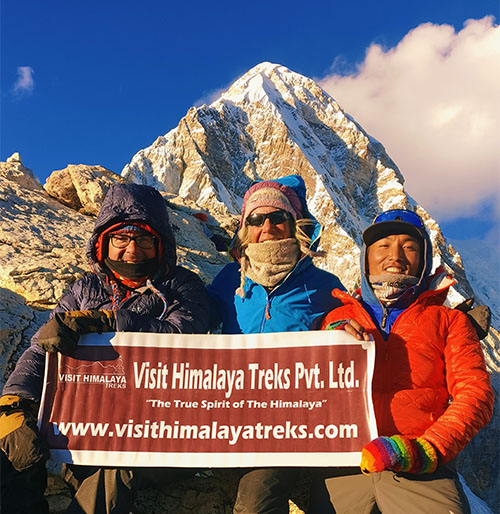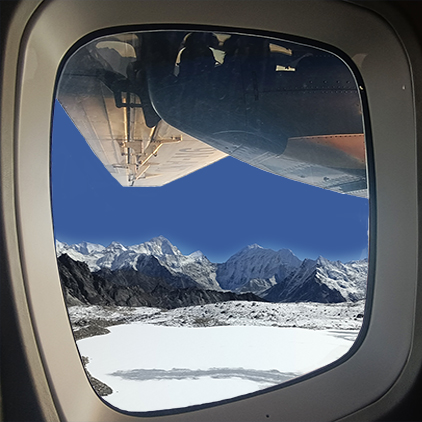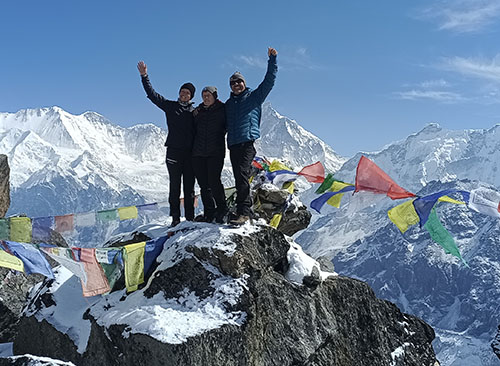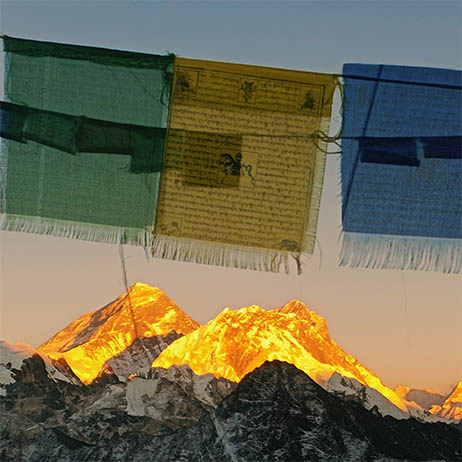This blog offers valuable insights into the demanding nature and level of difficulty of the Kanchenjunga Base Camp trek, as well as practical advice for navigating the stunning but isolated trails of the Kanchenjunga region. It serves as a comprehensive resource for trekkers looking to embark on high-altitude adventures in the remote Eastern Himalayan landscapes of the far eastern region.
Nepal, renowned as a trekker's paradise in the Himalayas, presents numerous awe-inspiring trekking routes, each presenting its own set of unique challenges and rewards. Among these, the Kanchenjunga Base Camp Trek stands out. This trek leads intrepid explorers to the foot of the world's third-highest peak, and it is no easy feat. The journey involves traversing remote terrain, contending with high altitudes, dealing with unpredictable weather, and coping with seasonal variations in difficulty. Successfully conquering the Kanchenjunga Trek necessitates meticulous planning, thorough preparation, and a deep understanding of the landscape.
In the following sections, we will explore the various factors that contribute to the difficulty and challenges of the Kanchenjunga Base Camp Trek, as well as provide strategies to surmount them.
Kanchenjunga Base Camp Trek Difficulty Factors:
The Kanchenjunga Base Camp is one of the longest treks in and around the Nepal Himalayas. Due to its remote location towards the Eastern Rim of Nepal, the country of hills and high mountains. The walk, depending upon the starting point of trekking, mostly begins from the closer town of Taplejung at Suketar.
The trekking trail is almost the same all around the hills of Nepal, having short and some gradual sections. The rest of the walk leads to uphill and downhill for shorter or longer hours, as per the itinerary days.
The trail is well-defined except in some remote areas en route to Kanchenjunga South and North Base Camps. Mostly the path is well maintained around the villages, except when walking into a forest.
The Kanchenjunga Base Camp Trek difficulty factors depend upon one fitness level and stamina, where steep climbs and downs are normal in the Himalayas. The difficult factors are walking through previous landslide areas, and en route to Ghunsa village crossing three smaller passes in a day. The rest of the difficulty to experience is the rise in altitude to reach South and North Base Camp at Pang Pema.
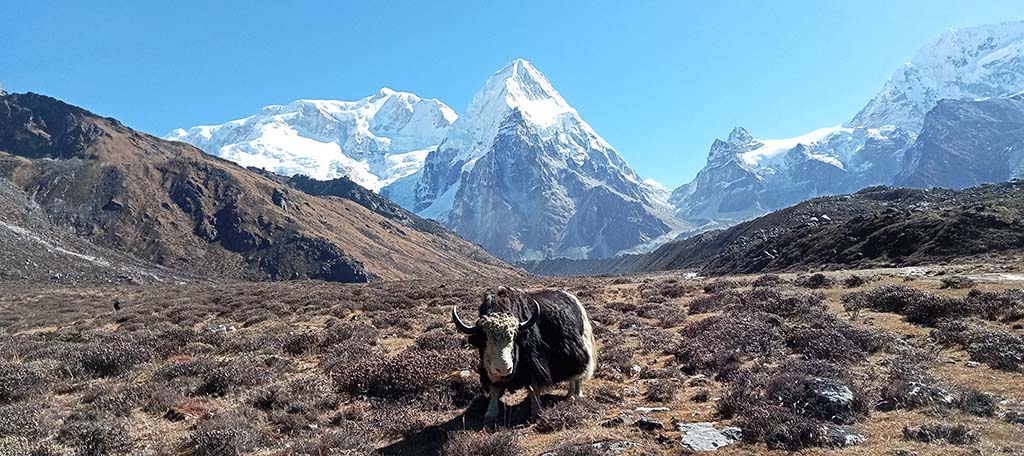
Remote Landscapes and Yak in Kanchenjunga Region Trek (Ramche KBC South Base Camp)
Remote Landscapes:
Nepal and its Himalayan destinations with various destinations around remote parts of the country. Likewise, the Kanchenjunga Base Camp is the mountain itself located at the edge of Nepal. Which borders Sikkim small northeast state of India, Mt. Kanchenjunga straddles the borders between these two countries.
Due to its remote landscapes and location, a long drive is involved to begin and end the treks. The shortest route as per the itinerary is flying to Bhadrapur low warm town airport of Eastern Nepal Terai. Then drive to the starting point of the trekking. At Taplejung in Suketar, a small airstrip and airport exists, but the flight is unreliable due to weather. Depending on the number of passengers, more motorable networks have reached most areas of the Taplejung district.
Making the trek more or less shorter than in the early days of past decades, the remote landscapes of the Kanchenjunga area are slowly getting shorter and more reachable due to the construction of motor roads around various major places in the Kanchenjunga region.
Food and Accommodation Facilities:
The Food and accommodation facilities are Spartan and very simple.
Due to its remoteness, as well as the low numbers of trekkers visit the Kanchenjunga region. After Ilam or Phidim, as per the itinerary, the lodge accommodations are simple but of homely comfort. Mainly sleeping in large dorms or twin-sharing rooms, having common toilets and bathrooms.
The food varies from one village to another remote settlement, and the food menu is limited. The main meal trekkers can enjoy is the famous Nepal Dhal-Bhat (Boiled rice, with various types of lentil seeds soup). Served with some seasonal vegetables and homemade pickles or fresh salads, includes Chapatti bread, Pancakes, and Tibetan bread.
As well as Noodle Soup with Veg or eggs, fried noodles or rice, Mo-Mo, and Dumplings either veg or with meats. Egg varieties can be ordered, but the meat products are scarce around the high Hilly region of the Himalayas. Breakfast can be oats porridge, muesli, or cornflakes with fresh milk, followed by bread, pancakes, or chapatti and eggs of choice.
Trekkers need to carry sleeping bags with inner liners, as well carrying some supplementary foodstuff. Like dry nuts/fruits, biscuits, or some packed bakery products, etc.
Long Duration Trek:
Kanchenjunga Base Camp, is certainly a long-duration trek, depending upon the choice of itinerary. To make it short one can choose to visit South or North Base Camps. But most trekking itinerary includes the full circuit with both North and South Base Camps of Kanchenjunga.
The trek originally was a long duration trek of more than 3 weeks, from the last few years. The construction of the motor road reached beyond Suketar and Taplejung, making the trek short of little more than two weeks. But still Kanchenjunga Base Camp is one of the long-duration treks around the Nepal Himalayas.
Unpredictable Weather:
Himalayan Weather patterns can be unpredictable, even at the best time of the year for trekking. Nepal has four main seasons likewise, spring from March to May, and summer/monsoon starts from mid-June to August. Including the autumn/fall seasons from September to November with the winter months of December to February. The main influx of trekkers and adventurers choose the best seasons of spring and autumn/fall.
Most days are fine and clear for views and walks but can be unfavorable with overcast days sometimes. Various reasons for changes in weather patterns around the Himalayas, as well as around the world.
Climate change is due to the Green House effect, and Global Warming, where the ozone layer is increasing every year. The unpredictable weather that affects the Himalayas is due to cyclones and storms in the Bay of Bengal, or Arabian Sea.
Sometimes cyclones and storms pass through the lower Gangetic plains and eventually end around the Himalayas. Making the weather miserable for trekking around the remote pockets of the Himalayas like in Kanchenjunga Base Camp Treks. The unpredictable weather also brings unexpected snowfalls and heavy rains around the green hills of the Himalayas.
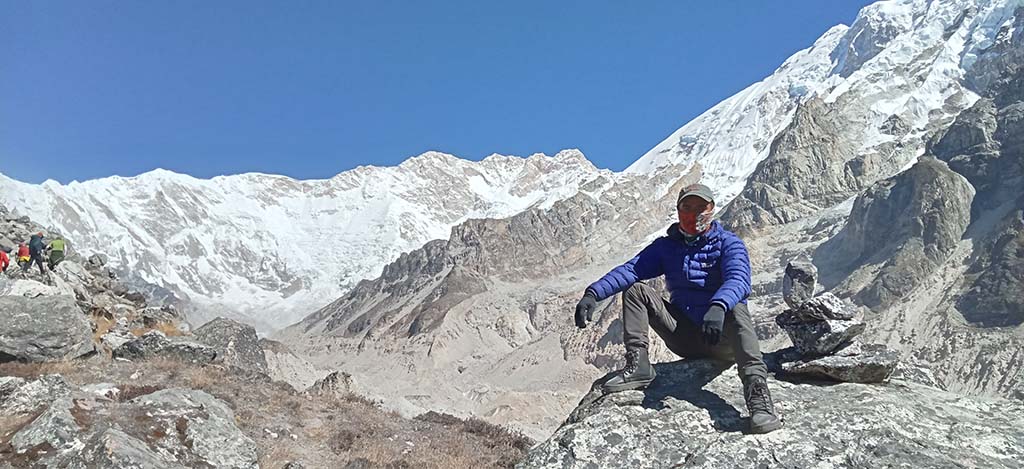
Close view of Kanchenjunga South from Oktang View Point.
Kanchenjunga Base Camp Trek Difficulty in Different Seasons:
The difficulty of Kanchenjunga Base Camp Trek depends on different seasons of the year, due to its remote location and sheer wilderness. Interested trekkers need to be aware of booking at the right seasons, to enjoy the wonderful trek to Kanchenjunga.
The difficulty, apart from physical fitness and health, the right time of the seasons plays a major role. Spring is a lovely time when wildflowers are in seasonal bloom as well with longer sunlight hours. The next right time is the beginning of autumn from September to early and mid-November. Most days are clear and fine for views and pleasant walks. But days are quite short due to limited sunlight hours, to cover long-distance walks as per the itinerary days.
Autumn (September to November):
Trekking and other adventure activities around the Nepal Himalayas, autumn/fall seasons from September to November. These are the best times to venture for treks to Kanchenjunga Base Camps as well as other Himalayan destinations.
In autumn/fall time from September to November, the weather is mostly fine during the day for views and walks. But much colder in the morning and late afternoon till the night time, where temperatures drop, as the altitude wise. Can get snowed sometimes above 2, 500 m higher, where days are much shorter due to limited sunlight hours. But one of the best times for Kanchenjunga Base Camp Treks and various regions of the Himalayas.
Spring (March to May):
Spring season starts from March to May, where days are perfect for treks to Kanchenjunga Base Camp. This is also the best time when wildflowers are in seasonal bloom, especially the rhododendron flowers. Trekkers can enjoy various species and colors of rhododendron, which is also the national flower of Nepal.
March to May is one of the best times for grand panoramic views of surrounding landscapes and snow-capped mountain ranges. As well for pleasant walks, when days are full of sunshine, and days are much longer with enough sunlight hours.
Much warmer during the daytime, but cold morning late afternoon, and nighttime, can get overcast in the afternoon. However, an enjoyable time for Kanchenjunga Base Camp Trekking, and other Himalayan destinations.
Off-Season Treks:
The off-season treks can be enjoyable, walking on serene trails, when most trekking areas will be quiet and undisturbed. Where only a few groups of trekkers seldom explore the remote corners of Kanchenjunga areas.
Off-Season Treks like in summer and monsoon time of June to August, most days are cloudy with monsoon rains. But can be interesting for nature lovers and botanist students, as the areas will be full of lush vegetation. Enriched with exotic flora and fauna, chances to see some wildlife, including various types of wildflowers in bloom.
The other off-season time is winter from December to February, much cold with freezing temperatures to experience. But an exciting time where most days are crystal clear for stunning views and pleasant walks.
Can expect snowfall around higher hills and at Kanchenjunga both base camps sometimes, however an enjoyable time. Walking on a less crowded trail, some of the settlements and lodges will be closed.
The people from higher villagers migrate to lower warm areas to escape the cold winter from December to February.
Tackling Altitude Sickness in the Kanchenjunga Base Camp Trek:
Tackling Altitude Sickness on the Kanchenjunga Trek is quite simple, as the walk leads to moderate altitude to begin with. As the trek progresses depending on the distance from a minimum of 4 hours to a maximum of 8 hours. Trekkers will be well acclimatized on daily walks up and down trails, as well as spending overnights at certain heights.
The main process of tackling altitude sickness on this trek to Kanchenjunga Base Camp is heading at a slow pace. Walking at your own easy pace and stopping before getting breathless, as well as enjoying the surrounding views.
There are various ways for precautionary measures to tackle altitude sickness, drinking enough fluid. Having rest where required, sound sleep, and good nutritious meals, where available. But the trek more or less is enjoyable from moderate to adventurous walks with slow altitude gain.
Trek at a Gradual Pace:
The most important is to enjoy the treks, walking at a leisurely pace and having time to admire the surrounding scenery. Save your energy by taking things slowly and walking at a normal easy pace. This will make the adventure worth an experience to achieve the goal and highlight visiting both Kanchenjunga base camps.
Elevation Gain:
Elevation Gain on Kanchenjunga Base Camp Trek begins with average and good heights of less than 2,000 m. The elevation gain depends upon the itinerary days, stopping for overnights and then heading for the long day walks. The elevation gains with ups and downhill walks, reaching high and then reaching lower altitude. The rise in height of ups and downs but, average reaching above 3,000 m high to both base camps.
Where elevation gain gets rapidly higher on the other northern side of Kanchenjunga base camp. Reaching the highest point of the trek at Pang Pema above 5,140 m, where Kanchenjunga North Base Camp is located.
Diamox Tablets:
Diamox Tablets is the name of a pharmacy brand, which contains Acetazolamide drug. Which is normally used in clinics and hospitals, to decrease headache, tiredness, nausea, dizziness, and shortness of breath. It is also a treatment for swelling of heart disease, which most trekkers and mountaineers use at present.
Especially for long high-altitude treks and crossing higher passes, as well as mountaineering climbs. Most trekkers, adventurers, and mountaineers carry as a backup medicine for prevention or lessening of symptoms related to mountain sickness. Where climbers attempt a rapid ascent and those experiencing mountain sickness despite gradual ascent.
Diamox can be used after getting advice and recommendations from medical personnel and doctors.
Nutritious Meals:
Nutritious Meals is always a good support in keeping one healthy and fit throughout the treks. On adventures around the high Himalayas like Kanchenjunga base camp treks, it is important and necessary to be physically fit.
As well-being in sound health to enjoy the adventure of Kanchenjunga Base Camp Trek. Walking ups and downs can lose your body weight and make you feel weak. Having nutritious food always keeps you fit and energetic on walks carbohydrate food is the best. It is a supplement to your energy keeping you strong on daily walks, carbohydrates food is the best example.
Like rice, noodles, pasta as well and wheat-based breads, besides carbohydrate foods. Some proteins are essential, meats, eggs, vegetables, and so on, including broth, soups, and other dairy products, milk, butter, and cheese.
Proper Hydration:
To keep oneself fit and strong on trekking, it is necessary to keep your body well, having a lot of fluids. Like clean drinking water, black tea, soups, and carrying rehydration powder to mix with the water. All the mentioned items keep you from dehydration, as walking makes you sweat in the heat.
As well, having too much exercise or longer hours of walking can reduce body fluid. Which leads to dehydration, and can make you tired, fatigued, and weak. On treks carry a good strong and light water bottle about a liter to 2 liters for the day walks.
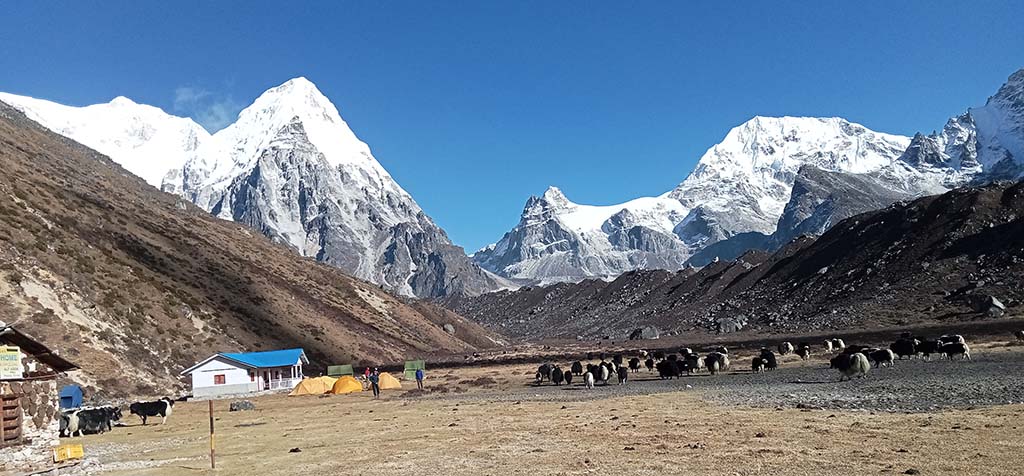
Ramche is known as Kanchenjunga South Base Camp.
Reducing Kanchenjunga Base Camp Trek Difficulty:
Even though it sounds challenging, we can enjoy the adventure and make a lifetime memory by reducing the Kanchenjunga Base Camp Trek difficulty. As well as to enjoy the beautiful surroundings and stunning scenery of towering snow peaks and local cultures. The main ways to reduce the difficulty depend first on itinerary days. Some company itineraries can be different with shorter or longer days of walking.
The other things to be aware of are the altitude gain in a day, as well as the trail conditions. All these lead to difficulty for some trekkers to cover the long hour distance on time to reach the overnight destination.
Private groups of families, friends, or senior college groups can request customized or Tailor-Made itineraries. To suit your holiday duration for the treks, as well to make the longer days walking much shorter.
The rough terrain trails, bad weather, or walking on landslide sections as well as walking on snow make the trek much difficult. But having time to reach your overnight destination and taking a slow and easy pace will make the trek enjoyable.
Acclimatization and Regular Hydration:
The only ways to keep fit and to enjoy the trip to Kanchenjunga Base Camp Trek. Having acclimatization and keeping oneself rehydrated makes you feel good to enjoy the whole trekking. One should be careful in choosing itinerary days, where some days could be long and short.
The best itinerary with acclimatization days, allowing trekkers with leisure time to enjoy and explore the surroundings. As well have plenty of liquids to drink from being dehydrated, which can lead to complications along with altitude sickness.
Hiring Professional Guides and Porters:
When booking for a longer adventure like the Kanchenjunga Base Camp Trek, make sure that the company provides an expert guide. Who knows the areas like the back of his hand, a professional guide having a Government License to lead the treks? Besides professional guides, the most important, and backbone of the trek is porters, choosing the best strong and cheerful porters. Having a team of good staff, a professional guide, and strong friendly porters makes the trek more enjoyable.
Best Time for the Trek:
The best time for treks and other various adventures around the Nepal Himalayas, including Kanchenjunga Base Camp. Spring and autumn are the right seasons, spring is from March to May, and autumn/fall begins from September to November.
Spring time when days are much longer with sunny days can cover much distance due to enough sunlight hours. Likewise, autumn/fall of September to November is also a perfect season when most days are crystal clear for views and walks.
But shorter days, due to limited sunlight hours, get dark soon and the sunrise is a late but enjoyable time. It can be much colder in the morning and nighttime with chances of snowfall sometimes.
Training for the Trek:
For longer trekking adventures around the Himalayas, as well as for Kanchenjunga base camp. Where all members should be fit and healthy, some exercise should be an advantage. Before and after signs for the treks, like walking, and jogging for an hour every day. Walking up and down stairs, as Nepal’s landscapes are full of ups and downs, a good pre-training before the trip will be the best.
Customizing the Trek Itinerary:
Private parties and families, including senior college groups, can request for Tailor-Made or Customized best Itinerary. If the group departure dates are not suitable for you, inform us "Visit Himalaya Treks" for a private trekking itinerary.
We Visit Himalaya Treks will set and fix the itinerary days according to your request with your holiday duration for the treks. Can extend or shorten the itinerary for some days as per one choice to make the trekking more enjoyable and worthwhile.
Altitude Challenge/Altitude Considerations:
On treks, altitude challenges and considerations depend upon one’s attitude, as well as with fitness level. Including the itinerary days of longer day hours of walks to reach the designated overnight stops. The altitude challenge will become easier as the trek progresses, enjoying the tough or easier part of the day.
But more or less one should be aware of rapid altitude gain on some days, like crossing the three passes. Likewise, after visiting the Kanchenjunga South Base Camp and then crossing Sinelapche Bhanjyang 4646 meters, Mirgin la Pass 4480 meters and Sinion La Pass 4440 meters (Sele le La Pass ) Although it is not higher than 4646 meters. But it can be quite strenuous getting across these passes in a day, with steep ups and downs. The good thing is trekkers will be well acclimatized, visiting the South Base Camp and getting used to the terrains.
The highest point at 5,150 m / 16, 896 feet high on reaching Kanchenjunga North Base Camp at Pang-Pema. Apart from altitude challenges to consider are the trail conditions in some sections of treks. This leads to narrow paths and over landslide areas, the danger of rock falls are things to consider, then gain in altitude.
Long Duration:
The long duration of the itinerary can lead to tiresome walks for some days. But it is more or less enjoyable and exciting to enjoy the adventure of Kanchenjunga South Base Camps. The long hour walk is from Tseram to reach Kanchenjunga South Base Camps and around Yalung Glacier.
Then the next longer duration was a steep climb to cross over three passes of Sinelapche Bhanjyang 4646 meters, Mirgin la Pass 4480 meters, and Sinion La Pass 4440 meters (Sele le La Pass).
Physical Demands:
Physical demands and challenges depend upon one fitness level and health-wise, including the hours of itinerary days. Some days can be much longer distances to cover in a short duration of time to reach the designated overnight stops.
Apart from the physical demands, steep climbs at higher altitudes can make each and every trekker tired. It is also a great physical exercise to test your strength, and capability, which all trekkers can experience around the Himalayan region. Especially on Kanchenjunga Base Camp Treks of about three weeks’ duration, which involves many ups and downhill walks.
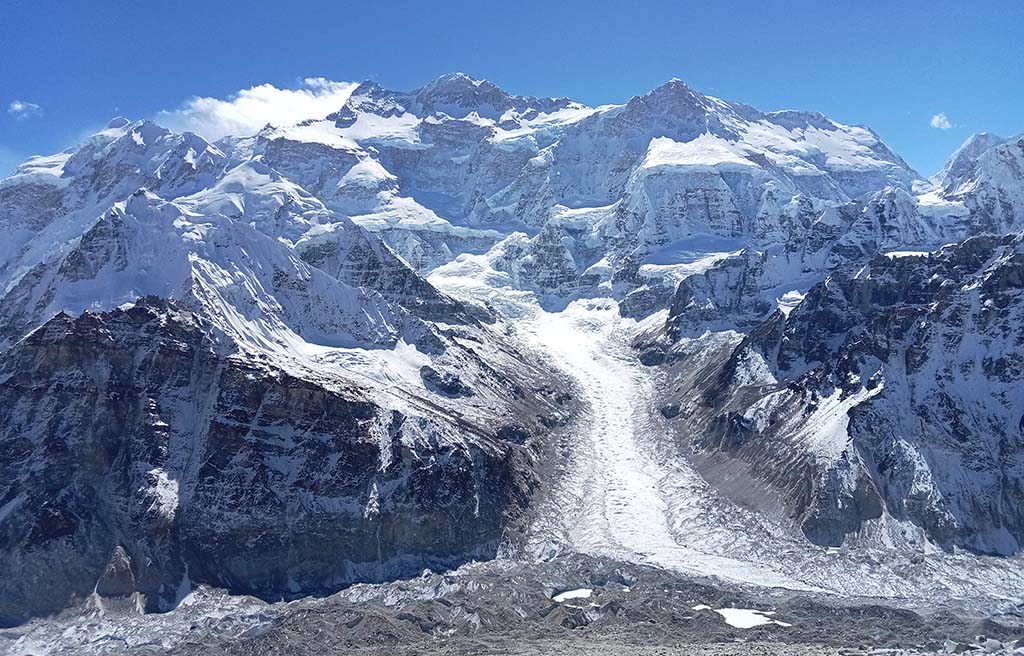
Close view of Kanchenjunga's North side.
Remote and Rugged Terrain: One major reason for Kanchenjunga Base Camp Trek difficulty:
The remote and rugged terrain landscapes are what one can expect on Kanchenjunga Base Camp Trek. The ending point of the Nepal Himalayas extends towards the Far Eastern of the country. The remoteness of the Kanchenjunga Himalayas makes the trek of longer duration, involving flights and drives both ways. Its remote location makes the areas steeped with rugged terrains of huge rocky cliffs and gorges. As well as walking on rough vague paths sometimes, around the rugged terrain country landscapes.
Cultural Sensitivity/ Cultural Experiences:
Cultural Sensitivity to experiences leads to various cultures, especially around the mid-hills of the Kanchenjunga region of Taplejung district. The middle hills with more villages and towns with vast farm fields and terraces, these areas are dominated by the Kirat. The main hill tribes of Far Eastern Himalayas follow Hinduism as well as practice Shamanism.
They worship nature and the soul and spirits of their ancestors, the other minor tribes are Hindu Bharamins, Chettries, and Dalits. The Hindu people have their temples and celebrate various festivals according to the Hindu lunar calendar with auspicious days. The other tribes are Gurung, Magar, and Tamang interwoven to Tibetan Buddhism, as well as some are Hindus.
Higher above 2,500 m dominated by the Sherpa and Bhotias mountain tribes of strong Tibetan influence in culture. As well as with Buddhism religion due to their close link with Tibetans across the border beyond the Kanchenjunga Himalayas.
Permits and Logistics:
Permits and logistics are equally important and necessary for Kanchenjunga Base Camp treks or any other adventures in Nepal. Trek along the Kanchenjunga requires special permits and Kanchenjunga Conservation entry permits which we Visit Himalaya Treks will manage all necessary permits for trekking to Kanchenjunga. Kanchenjunga Area Conservation Project, which is the 3rd conservation area in Nepal established in 1997.
Apart from permits for Kanchenjunga base camp treks, logistic planning is most important, due to its remote location. From transportation, the number of field staff with guides and porters to allocate, along with good lodge accommodation and food. As the Kanchenjunga area is a fresh and raw country for commercial trekking, good planning with logistic support is essential. In some wilderness around Tseram towards South Base Camp and at Lhonak from Ghunsa onwards.
Tented camping is required to carry along with food and camping equipment to provide money worth of good services. Including safe and fastest means of transportation before and after completing the treks, which is equally important as logistic support.
Weather Challenges: which is another reason for the Kanchenjunga Base Camp Trek difficulty:
After good preparations for Kanchenjunga Base Camp Treks, having all the best logistic support from the local agencies. The main factor to enjoy the trek is having favorable weather en route. Hoping the weather stays good and perfect throughout the trekking days, but sometimes the Himalayan weather can be challenging. Even in the best time of the season, the weather can be unfavorable with overcast days sometimes.
Including heavy rains on the mid-hills with heavy snowfall around the higher areas. Trekkers should understand and compromise on booking the treks to Kanchenjunga Circuit Trek, or any other treks around the Himalayas. The Himalayan Weather is unpredictable, and unreliable sometimes which can lead to great challenges on route trekking.
However, the staff and guides will do their best to minimize the inconvenience under their command. As well as to make the trip a great success and enjoyable.
Conclusion to Kanchenjunga Base Camp Trek Difficulty & challenges:
Interested travelers around the world are planning for a great wonderful adventure to Kanchenjunga Base Camp trekking. It will be a mesmerizing walk for three weeks that involves a panoramic flight and scenic, exciting drives. The trek is pleasant and enjoyable, as is Kanchenjunga Base Camp.
The reason for the difficulty of the Kanchenjunga Base Camp Trek is due to off-the-beaten trail adventure. Slowly the remote areas of Kanchenjunga are slowly being exposed to the outside world. As one of the most marvelous regions for trekking in a quiet tranquil environment, away from mainstream trekking trails.
Certainly, a great adventure to experience for three-four weeks in harmony with beautiful and scenic surroundings. As well as visiting the both South and North Base Camps in one single journey of great dramatic variation.





